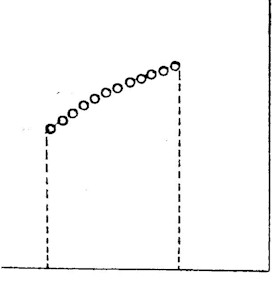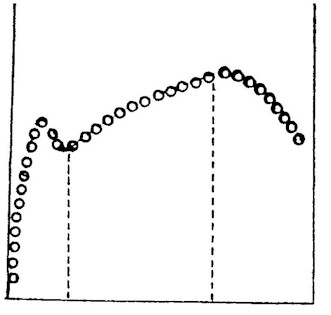THE REVERSE EFFECT
NOHA Board of Directors member Walter A. Heiby has just published a large compendium The Reverse Effect: How Vitamins and Minerals Promote Health and CAUSE Disease, MediScience Publishers (Deerfield Illinois).* This book, the result of many years of research, contains "more references (4821) than any other single-author book ever published." Summarizing his thesis concerning "the reverse effect": many research projects show an increasingly positive health effect when the intake of a certain nutrient is increased through a particular range.

range of experiment
Then the public and even some scientists imagine that the same positive relationship will continue outside the range of the experiment. Yet researchers have often found that increasing the nutrient beyond the highest amount in the original experiment causes a plunge into negative effects and that reducing the nutrient below the lowest amount results at first in unexpected improvement. His cover diagram illustrates these "reverse effects." One is reminded of the mistaken folk wisdom "If a little helps, a lot will help a lot more" or of the Hindu proverb "It is possible to drown in nectar."

original experiment
Heiby has an excellent chapter on the details of experimental protocols – the ways in which many factors, often not considered by the experimenter, affect the outcome with living animals, including human beings (in vivo). For example, results can change with noise or cage position relative to a light source. Or, crowding in cages can result in the aggressive animals eating while others may starve – obviously tremendously affecting the death rate with a factor that has nothing to do with a particular vitamin or mineral added to the chow.
. . . researchers have often found that increasing the nutrient beyond the highest amount in the original experiment causes a plunge into negative effects and that reducing the nutrient below the lowest amount results at first in unexpected improvement. His cover diagram illustrates these "reverse effects."
Many of the experiments reported by Heiby are in vitro (literally, "in glass"), which means that tissue has been taken outside a living body and is maintained in an artificial environment, the constituents of which are known, so that the scientist can add, say, a particular mineral, in a certain amount, and observe what happens to the cells in the tissue. This is one way in which scientists can begin to get knowledge. However, living beings are tremendously more complicated! Heiby points this out vividly: "It is difficult to relate in vitro results to possible in vivo actions. The in vivo milieu is almost infinitely complex and variable compared with the relative simplicity of the in vitro conditions. Furthermore, the in vivo concentration of each vitamin, mineral, drug, enzyme, hormone, or other body chemical may vary from organ to organ. Vitamin C, for example, concentrates in the adrenal gland and zinc in the prostate."
With many years of effort, Heiby has gathered and collated scientific research on vitamins and minerals and their interrelationships with health and disease. As his work is carefully indexed, it is easy (and can be fascinating) to pursue one particular subject. He encourages his readers to go to the original sources and, if a particular article is of interest, to watch Citation Abstracts, which will give all subsequent articles referring to that article either critically or with praise. Heiby has gathered together many authors who report opposite results, indicating that the reader needs to keep an open mind! In his analysis of seemingly conflicting results, he finds that sometimes the protocols do not match. Or later research will be done with different amounts of the vitamin or mineral, and a reverse effect will be apparent.
Heiby has gathered together many authors who report opposite results, indicating that the reader needs to keep an open mind! In his analysis of seemingly conflicting results, he finds that sometimes the protocols do not match. Or later research will be done with different amounts of the vitamin or mineral, and a reverse effect will be apparent.
Throughout the book he is careful to list the food sources of the various vitamins and minerals. When taken as supplements they can affect certain medical tests, which he lists carefully, and there can also be drug reactions. A typical warning is:
If you are under a physician’s care, be sure to tell him if you are taking thiamin (or any other vitamin or mineral). In some cases the thiamin might interact with drugs he may have prescribed. M. Soukop and K.C. Calman reported that cancer patients on fluorouracil therapy were found to be thiamin-deficient. When the thiamin was replaced there was a rapid progression of the tumors. We often hear the advice that drugs will cause vitamin deficiencies (that’s true) and that we should take vitamin supplements to compensate. (That could be false.)
Here are some examples from his vast number of reverse effects:
|
|
Heiby has a great number of references on vitamins and minerals that at some doses counteract and at others promote cancer.
". . . cancer patients on fluorouracil therapy were found to be thiamin-deficient. When the thiamin was replaced there was a rapid progression of the tumors. We often hear the advice that drugs will cause vitamin deficiencies (that’s true) and that we should take vitamin supplements to compensate. (That could be false.)"
While not examples of the reverse effect, many substances provide instances of health trade-offs. Consider chlorine:
The chloride component of salt is useful in making the stomach’s hydrochloric acid, which is required for protein digestion. Chloride also helps the liver in its detoxifying action, although an excess will tend to destroy vitamin E. Chloride is a constituent of enzymes used for digesting fats and starch. Adequate chloride seems to be especially important in the case of potassium deficiency. . . . [However,] we saw earlier that chlorine, rather than sodium, may be the detrimental constituent of salt. Chlorine has other bad aspects. Robert Harris, author of the Environmental Defense Fund study published by the Environmental Protection Agency, is very concerned about the carcinogenic properties of chlorine. He is quoted in Science as saying that chlorination "could conceivably be an important cause of cancer, probably not as important as cigarettes but maybe not dramatically less." Science goes on to explain, "The reason is that chlorine has recently been found to react with humic acids often present in water to produce a family of compounds known as trihalomethanes, one of which is chloriform, a confirmed cause of cancer in animals." Swimming pool water, with its organic contaminants, . . . when chlorinated has been found to be mutagenic. . . . These chlorinous gasses [emanating from swimming pools] can produce wheezing in sensitive persons and the problem is exacerbated by heat reclamation systems that recirculate pool air. . . . Yet another danger of chlorine compounds exists in typewriter correction fluids (e.g., Liquid Paper®, Wite-Out®, Snopake®, etc.). . . . The trichloroethylene and perchloroethylene in these products, when inhaled, can cause cardiovascular, respiratory, hepatic, and renal damage, and mental phenomena, such as delirium. . . . [On the other hand,] chlorination of water has virtually eliminated cholera epidemics, so hasty solutions may be regretted later.
". . . chlorination 'could conceivably be an important cause of cancer, probably not as important as cigarettes but maybe not dramatically less.' . . . [On the other hand,] chlorination of water has virtually eliminated cholera epidemics, so hasty solutions may be regretted later."
An impressive number of world scientists endorse The Reverse Effect. A few, including Nobel Laureate and NOHA Honorary Member Linus Pauling, disagree with parts of it. Donald J. Cram, Nobel Laureate, Chemistry, 1987, observes, "The book is scholarly and appropriately tentative in its conclusions. . . . The Reverse Effect is provocative in pointing to the complexity of metabolism and helps to separate fad and fancy from good science."
Although scientific knowledge of the constituents of cells dates only from the 1940s, Heiby is optimistic about the vast increase in knowledge about nutrition. "In the past 15 years over 100,000 articles relating to nutrition have appeared in the journals covered by Index Medicus, Excerpta Medica, and Nutrition Abstracts." In his final chapter he speculates about research that may lead to life extension not only in terms of years, but also in terms of optimal vitality. At the present time, he wants us to be able to ask our doctors intelligent questions about their proposed treatments and about alternative therapies. His remarkable compendium of knowledge includes a vivid metaphor: "Throughout this book we will see how health is a game of countless teeter-totters of nutrients, exercise, mental effects, etc. A book, a nutritionist, or your physician may make suggestions as to how to balance the teeter-totters, but ultimately the decisions will always be yours."
_________________________
* At $59.50, this 1216-page book is $0.05 per page, as against $0.125 per page for the average book in the natural sciences.
Article from NOHA NEWS, Vol. XIX, No. 1, Winter 1989, pages 1-2.